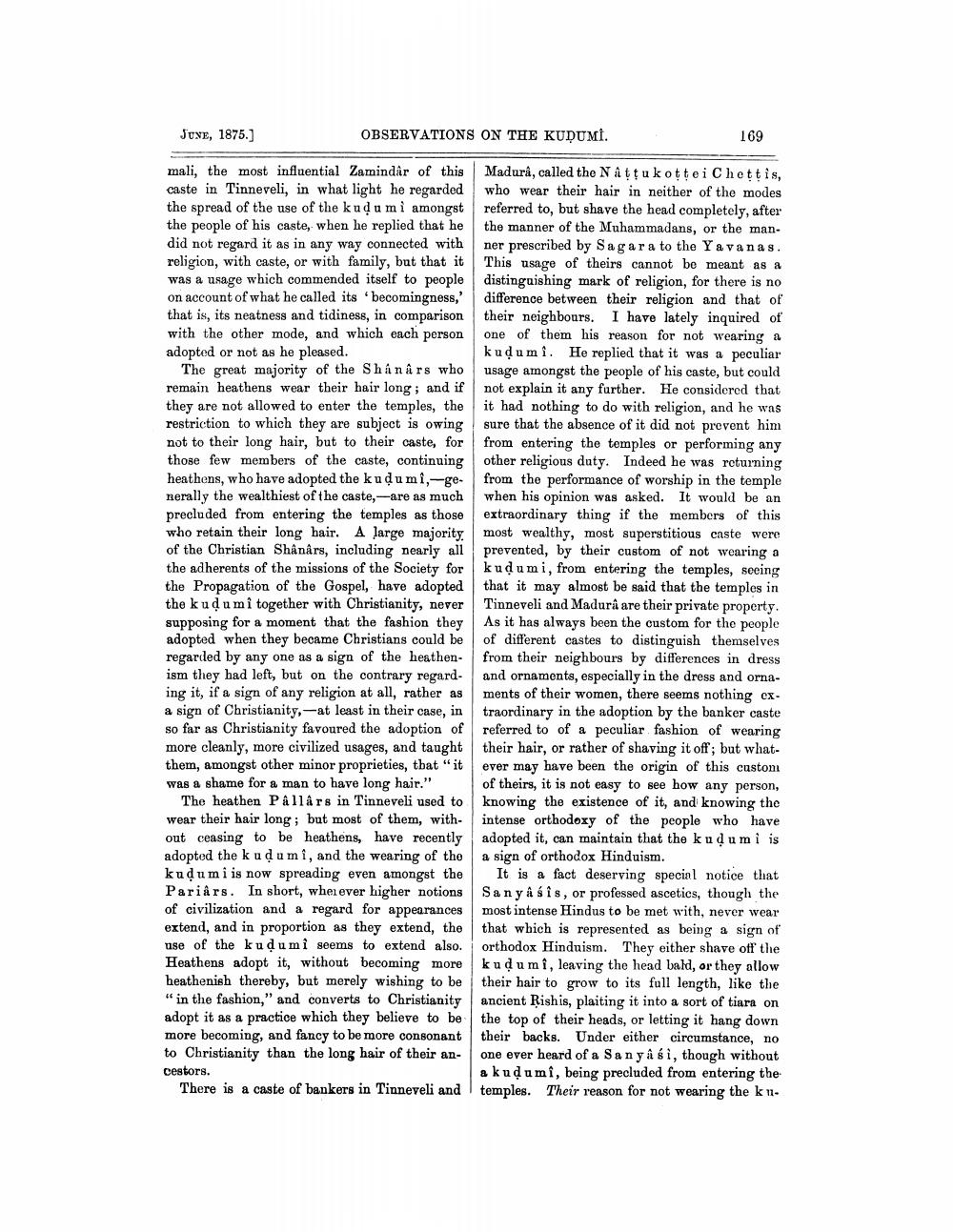________________
OBSERVATIONS ON THE KUDUMI.
JUNE, 1875.]
mali, the most influential Zamindar of this caste in Tinneveli, in what light he regarded the spread of the use of the kudu mi amongst the people of his caste, when he replied that he did not regard it as in any way connected with religion, with caste, or with family, but that it was a usage which commended itself to people on account of what he called its 'becomingness,' that is, its neatness and tidiness, in comparison with the other mode, and which each person adopted or not as he pleased.
The great majority of the Shán års who remain heathens wear their hair long; and if they are not allowed to enter the temples, the restriction to which they are subject is owing not to their long hair, but to their caste, for those few members of the caste, continuing heathens, who have adopted the kudumi,-generally the wealthiest of the caste,-are as much precluded from entering the temples as those who retain their long hair. A large majority of the Christian Shânârs, including nearly all the adherents of the missions of the Society for the Propagation of the Gospel, have adopted the kudu mî together with Christianity, never supposing for a moment that the fashion they adopted when they became Christians could be regarded by any one as a sign of the heathenism they had left, but on the contrary regarding it, if a sign of any religion at all, rather as a sign of Christianity, at least in their case, in so far as Christianity favoured the adoption of more cleanly, more civilized usages, and taught them, amongst other minor proprieties, that "it was a shame for a man to have long hair."
The heathen Pâllârs in Tinneveli used to wear their hair long; but most of them, without ceasing to be heathens, have recently adopted the k uḍum î, and the wearing of the kudumi is now spreading even amongst the Pariârs. In short, whenever higher notions of civilization and a regard for appearances extend, and in proportion as they extend, the use of the kudumi seems to extend also. Heathens adopt it, without becoming more heathenish thereby, but merely wishing to be "in the fashion," and converts to Christianity adopt it as a practice which they believe to be more becoming, and fancy to be more consonant to Christianity than the long hair of their an
It is a fact deserving special notice that Sanyasis, or professed ascetics, though the most intense Hindus to be met with, never wear that which is represented as being a sign of orthodox Hinduism. They either shave off the kudumi, leaving the head bald, or they allow their hair to grow to its full length, like the ancient Rishis, plaiting it into a sort of tiara on the top of their heads, or letting it hang down their backs. Under either circumstance, no one ever heard of a San y â sì, though without a kuḍumi, being precluded from entering the There is a caste of bankers in Tinneveli and temples. Their reason for not wearing the ku
cestors.
169
Madurâ, called the Nattukottei Chettis, who wear their hair in neither of the modes referred to, but shave the head completely, after the manner of the Muhammadans, or the manner prescribed by Sagara to the Yavanas. This usage of theirs cannot be meant as a distinguishing mark of religion, for there is no difference between their religion and that of their neighbours. I have lately inquired of one of them his reason for not wearing a kuḍumi. He replied that it was a peculiar usage amongst the people of his caste, but could not explain it any further. He considered that it had nothing to do with religion, and he was sure that the absence of it did not prevent him from entering the temples or performing any other religious duty. Indeed he was returning from the performance of worship in the temple when his opinion was asked. It would be an extraordinary thing if the members of this most wealthy, most superstitious caste were prevented, by their custom of not wearing a kudumi, from entering the temples, seeing that it may almost be said that the temples in Tinneveli and Madurâ are their private property. As it has always been the custom for the people of different castes to distinguish themselves from their neighbours by differences in dress and ornaments, especially in the dress and ornaments of their women, there seems nothing extraordinary in the adoption by the banker caste referred to of a peculiar fashion of wearing their hair, or rather of shaving it off; but whatever may have been the origin of this custom of theirs, it is not easy to see how any person, knowing the existence of it, and knowing the intense orthodoxy of the people who have adopted it, can maintain that the k uḍumi is a sign of orthodox Hinduism.




